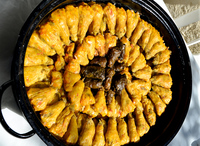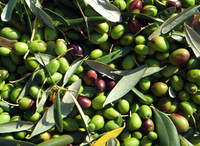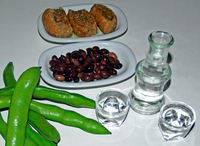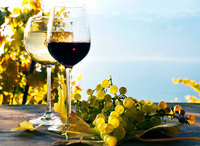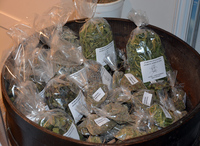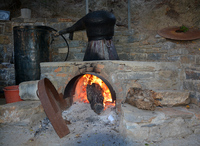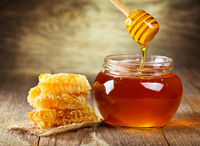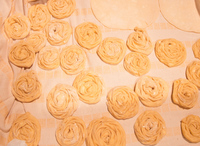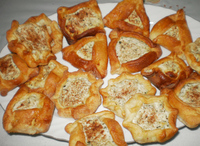
The close links of Crete with Europe are widely recognized, since Crete is the place where the continent received its name. In Greek mythology, lust-loving Zeus, in the guise of a white, winged bull carried off on his back the beautiful princess of Phoenicia, Europa, daughter of king Agenor, to the island of Crete where he fathered the progenitors of a magnificent civilization known as the Minoans.
One of the basic elements of this civilization has been nutrition, or the way of production and consumption of food stuff. The Cretans have developed their ancient nutritional habits with everything that the Cretan land so generously provides: olive oil, wheat, wine, honey, legumes and vegetables, mountain greens and aromatic plants, low fat cheese, meat and fish; the base of the Cretan cuisine that according to the research over the last few years proved to be healthy and of great nutritional value. You can taste this cuisine in the traditional taverns and local restaurants.
This civilization, forged on such values as hospitality, honesty, and dignity can, without exaggeration, be considered as a culture of health. For thousands of years now, the dietary habits of the inhabitants constitute an on-going, informal biological experiment, the results of which highlight the soundness of the Cretan diet, as it was formally recorded in the "Seven Countries Study" by Dr. Ancel Keys. The consumption of olive oil, wine, legumes, fruit, vegetables, honey and herb tea offers a unique privilege to Cretans. It endows them with a long, healthy life with the lowest mortality indices in the world in terms of heart diseases and cancer. In modern times scientific research has confirmed the value of this dietary prototype which is highly recommended by experts in nutrition.
Crete is proud of the fact that today, 5000 years after the rise of the Minoan civilization, is in a position to offer humanity an excellent dietary prototype that greatly improves the quality and expectancy of life.

Olive oil forms a major part of the daily Cretan diet, the average annual consumption being over 35 liters per person, the highest in the world! Most families in Crete own some olive trees, not only to meet their daily needs, but also providing a second income. Sitian olive oil has won international acclaim, receiving many awards for its excellent quality and superior taste. Most visitors will unfortunately not experience olive picking, as this takes place during the winter months, the whole family helping out.
Ancient Greeks believe that Virgin Olive Oil is beneficial to human health and recommended it for afflictions as:
-Dermatological problems -Inducement of vomit -Lacerations and burns -Ear infections -Gynecological diseases -Birth controlToday, the modern medicine confirms that Virgin Olive Oil is beneficial for one's health and its consumption is recommended for many instances such as:
-Cardio circulatory illnesses -Prevention of breast cancer -Prevention of prostate cancer -Control of stomach ulcer -Control of diabetes -Sexual impotence -Diet for children and athletes -Diet for the agedThe Wine
Along the long and narrow body of the province of Sitia stretching from west to east, a high mountain range lays as a protective shield against the strong hot south winds blowing from the Libyan Sea.
Thus protected in the north side, overlooking the Cretan Sea, the Sitia's vineyards (part of the Cretan, the most traditional vineyards of Europe) begin from a height of 600 m. above sea level and stretch downhill towards the sea. They dominate the hillsides with the ancient terraces in a calcareous and sandy soil.

It's growing in the polymorph landscape of Sitia following it in its ever changing alteration of hills and valleys which pleasantly surprises and fascinates the visitor. In an ancient long co-existence with this natural environment, the local varieties of grapes endow the territory with a priceless richness of bio-diversity. The mild and without extremes winter, combined with long hot and dry summer, the long periods of sunlight during the year and the cool breeze of the Cretan sea, ensure ideal conditions to the germinate cycle of the vine. Thus it's not strange that Sitia holds a 4000 years old tradition in winery and vine cultivation. the confirmation comes from the Minoan Palace of Kato Zakros where the oldest cultivated vineyard was found.
Indeed, the wine production in Sitia region met great commercial success. Most notable periods, during its historical course, were the Roman era when Sitia's wines were transported to Rome and other Mediterranean destinations into well sealed amphoras and during the Venetian presence in Crete (12th-16th century) when the Cretan wine reached the zenith of its fame.
But even today the wine holds an important role in the model of the Cretan nutrition. A fact that contributed a great deal in the recognition of the local wine's values concerning health and longevity. And let us not forget that recent findings detected a great number of components which are acting as anti-oxidant in the human body.
The favorable soil and climatic conditions and the systematic cultivation of the area since the ancient times, produces excellent varieties of grapes from which the re-known Sitia wines originate.
The most common varieties are those of Liatiko, Muscat, Myrodato, Dafnato, Asyrtiko, Roman, Mantilari, Kotsifali, Vilana, Plito, Athiri, Thapsathiri and many more which upon and with their different combinations, the local producers depend to create the Sitia's wines. Wines for all gastronomic demands and stable tastes which last and remain intact through the years.
Visitors in late August and September will witness the grape harvest and will more than likely be offered an armful! Wine is still made in the traditional way by treading the grapes. The must left over is used to distil the local drink Raki. During October, the "Kazanemata", (raki-making sessions) are held you may see them at the roadside. Visitors are always welcome and given a sample. It is quite an exceptional experience!
The Olive Oil

Á truly priceless treasure indispensable in the daily nutrition of the Cretans since the dawn of history. It is produced in the beautiful olive groves which cover the hilly and mountainous embossed soil of the Sitia's land, under ideal soil and climatic conditions (extensive periods of sunshine, (mild and sweet winters, cool summers, natural fertile soils, clean atmosphere).
The fresh fruit juice of olives is produced in Crete since the Minoan era and it is a product obtained by mechanically processing the olive crop. It is consumed in its virgin form without further processing. It has a wonderful aroma, a fruit's like taste but mainly it is rich in remarkable biological, nutritional, preventive and therapeutically properties with beneficial action in the development and protection of the human system.
The olive oil centralizes the most benefits by comparison to any other oleaginous substances of those humans are consuming. On this fact agree and have concluded long and extensive laboratory and clinical researches. In additional to these conclusions, the same result has been reached by many independent epidemiological researches around the world. But the experience, deriving from the excellent results of the highly successful diet of the Cretan population, based on olive oil for many centuries ago; possibly represent the best possible proof. Among others those researches proved that the olive oil:
Cures gastrointestinal and hepatic diseases
 Deters the development of cholelithiasis and protects urinary system.
Deters the development of cholelithiasis and protects urinary system.
Comforts the diabetic patients
Protects the human skin against the sun rays
Exercises beneficial influence in the development of the human skeleton.
Extends the young ness of the human body
Precludes the appearance of arteriosclerosis and cardiovascular diseases and
various forms of cancer.
This is probably the main reason that more and more people in the developed world try to subsume to their eating habits the Cretan diet.
Traditional Cretan Food
Omaties
They are made from large intestines of pork and filled with rise, small pieces of liver, onion and almonds. Cooked in salted water.
Kakavia
Is made from various pieces of fresh fish. We add pieces of onion and potatoes in the saucepan. We then add fish, olive oil and water until the food is covered. We sprinkle salt and pepper and cook in high temperature.
Skari with tomato
We fry skari (native fish with a distinct taste). We add sauce from fresh tomatoes, pepper, salt, parsley and capsicum.
Kouloukopsomo
We damp dacus (toasted and hardened bread - wheat orbarley bread).We add salt, olive oil, finely chopped tomatoes.
Mizythropites
We first prepare dough from flour, olive oil, water and lemon .Then we make a pastry and with an (ordinary) glass we make circular pieces. In half of each piece we place mizithra (Iocal traditional cheese) and cover with the other half. We deep fry them and serve.
Artichokes with broad beans
We cook fresh broad beans in olive oil and water. We add fresh artichokes, garlic, anise and salt. When cooked we make a dense mixture (from flour and water). We then pour it in the saucepan letting it cook for a while.
Octopus in Vinegar
We cook the octopus until it softness. Then we add olive oil and vinegar. Instead of vinegar we can add wine or water.
Chochli (snails) boumbouristi
We wash well large chochli (snails) and fry them with their tongue lacing the frying pan. We add salt and olive oil. When fried we add tomatoes and vinegar.
Dolmades with vine leaves
We take half a kilo of vine leaves, 700 gr. Of rise, potatoes, onion, pepper, cumin. We then roll them up and place them to boil over medium heat.

Traditional Cretan Sweets
Xerotigana
We first prepare dough out of one kilo of flour, lemon juice and olive oil. Then we make rectangular pieces of pastry. We wrap them up and deep fry them in olive oil. In the end we pour over honey, sesame and sugar.
Stafidota
We make a pastry from one kilo of flour, 4 cups of olive oil, and 2 cups of orange juice, sugar and soda. We then cut pastry into small pieces and fill them up with grated raisins and bake them in an oven.
Kalitsounia
We make a pastry with 1 kilo of flour, sugar, olive oil, 4 eggs. We cut the pastry into circles using a (drinking) glass. We then fill them with fresh mizythra (Local traditional cheese) in which we have added sugar, honey, cinnamon, vanilla. We bake them in an oven.
The Secret of Cretan Longevity
The Keys' renowned study of seven countries, which was published in 1980, revealed that the health level of Cretans was the highest in the world. Cancers and cardio-circulatory disease were rare, since out of 100.000 people on Crete, there were only 9 deaths attributed to these diseases as opposed to 466 in Finland. It was further proven that this was largely due to the dietary habits of the Cretan, people, whose basic ingredient is olive oil.
The Products

For Cretans, the secret of longevity is very simple. They eat anything that their rich soil produces! They consume a lot of fruit, vegetables, greens, fresh produce, legumes, cheese and bread. Cretans use herbs to add flavor to their meals; they make sweets/cakes with natural sweeteners, honey and grape-juice syrup; while the excellent Cretan wine is an indispensable accompaniment to their meals. Cretans do not eat meat or, rather, they did not eat meat until a few decades ago. Meat has always had a ritual quality in Crete, and generally in Greece. In antiquity, Cretans consumed only the meat offered to the gods on the altar of sacrifice. In modern times, they consumed meat only a few times a year, i.e. during festivities or, if wealthy enough, every Sunday. In other words, the dietary code of Cretans has deep cultural and historical roots.
This, however, should not be considered as a limiting, or even a coercive practice that could undermine the richness of taste. On the contrary, the ingenuity of Cretans exploited fully the entire spectrum of ingredient combinations, which resulted in volumes of recipes for meals and deserts. Snails, for example, are cooked in 40 different ways! Pure olive oil is the sine qua non for all preparations! Fresh produce grown under the most suitable climatic conditions has a prominent place on dinner tables. Cretans do not require doctor's orders to consume large amounts of fruit and vegetables. Grapes, raisins, oranges, etc. are a way of life. Even on days strictly associated with meat-eating, such as the Easter Day, Cretans do not eat only meat. On the contrary, they cook meat with artichokes, wild greens or vegetables a delicious choice!
The Results
Mr. Serge Renaud, a French researcher-scientist said, "Following a 15-year follow-up study, it was concluded that Crete manifests the lowest mortality rates irrespective of the cause of death". There is no doubt that the above statement attests to the benefits of the Cretan diet. The French scientist was referring to wide scale research on nutrition that was conducted with the participation of seven countries, including Greece, in 1956 by Dr Ancel Keys, a pioneering investigator and health revolutionary American. Today, the international community has adopted the Cretan model of nutrition by recommending it, as the basis of human nutrition.
Ancel Keys, 1986 compares mortality rates among various regions of the world, including four Mediterranean regions. Crete is last with respect to death causes with a significant difference from the country before last.
Also we have a comparison between the results from the above mentioned study in the seven countries (up to 1986) and pertinent statistical data provided by the World Health Organization (WHO) per 100,000 participants (Serge Renaud, 1995). Again, Crete is at the bottom of the list with regard to mortality rates.
In addition to the above, we have the results from a French study in Lyon. The French doctors divided their patients with heart diseases in two groups. The first group was put on a diet recommended by the US Society of Cardiology -- a low fat/cholesterol diet -- and served as control group. The second group was prescribed the Cretan diet to be followed during their normal way of life. The results were statistically significant. In two years mortality rates in the second group dropped by 75%!
Modern Cretans feel the urge to share their secrets of life with the world. Besides their history and culture, they are also willing to share with people their prized cultural heritage known as CRETAN DIET. Cretans would like to let the world know of a gigantic effort taking place on the island to preserve traditional values and nutritional customs, in spite of the influx of promotional activities favoring foreign nutritional habits, mainly that of fast food.
Cretan producers and local processing, packaging, and marketing companies warrant that all Cretan products are pure, without chemical substances or other preservatives and additives. Cretan products, being part of a centuries old tradition, are treated with the same respect as that afforded to them by our ancestors
"Crete's mystery is extremely deep. Whoever sets foot on this island senses a mysterious force branching warmly and beneficently through his veins, senses his soul begin to grow."
Nikos Kazantzakis, Report to Greco
Civilization
The olive is a favorite subject in Minoan art. Olive trees, olive branches and olive blooms are depicted in many wall paintings and relief works, found at the palace of Knossos ( 1600-1400 BC) and displayed in the Heraclion Museum today. Of the most well known, is the wall painting depicting an olive tree between wild goats, the relief with the bull and the olive tree at the balcony of the northern entrance of Knossos Palace, the wall - painting with "The dance in the Sacred Grove" and other scenes with , olive foliage, blooming branch, branches and relief olives.
Olive branches and leaves are often depicted on the vases of the Minoan period. Characteristic examples are to be found in the storage-jar discovered at the small island Psira off the coastline of north-eastern Crete which is decorated with bull' s heads and olive shoots on either side (1600-1500 B.C) as in the cup with the olive branch in bloom from Knossos ( 1600-1500 B.C), both now displayed in the Heraklion Museum.
The olive was a favorite subject even in the craft of gold-plating in the Minoan period. Characteristic of this is the superb piece of jewelry made up of a bunch of golden olive leaves found in the pre-palatial cemetery on the small island just outside today's settlement of Mochlos to the north of the village of Lastros in Sitia.
At the Olympic games that started in 776 B.C., ancient Greeks were crowning the winners with a wreath ("Kotinos") made of branches cutted always off the same wild olive tree.
Also at the Panathenea games ( 600 B.C), the winner' s prize was a decorated amphora, full of olive oil which was produced of the "Mories" (Sacred) olive-trees belonging to Goddess Athena.





